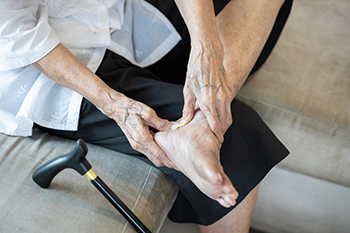Connect With Us
Blog
Items filtered by date: April 2022
Sever’s Disease Symptoms

Sever’s disease is related to swelling and irritation of the growth plate in the heel of the foot during puberty (typically 9 to 14 years of age). The growth plate, an area of the foot that is weaker and more apt to sustain injury than the rest of the bone, is a layer of cartilage in the foot near the end of a bone where most of bone growth occurs. During a growth spurt, muscles and tendons can become tight and pull on the growth plate. Activities like sports or prolonged standing can aggravate this condition. A child who has Sever’s disease might complain about tenderness or pain in one or both of their heels, experience stiffness in their feet upon awakening, start limping or walking on their tiptoes, or feel pain when their heels are squeezed from both sides. If your child is experiencing heel or foot pain of any sort, a visit to a podiatrist is suggested for proper diagnosis of the problem and appropriate treatment. If properly treated (with rest, ice packs, over-the-counter pain relievers, shoe inserts, or more), Sever’s disease is usually not long-lasting or chronic.
Making sure that your children maintain good foot health is very important as they grow. If you have any questions, contact Dr. Royall of Mountain View Foot & Ankle Clinic. Our doctor can provide the care you need to keep you pain-free and on your feet.
Keeping Children's Feet Healthy
Having healthy feet during childhood can help prevent medical problems later in life, namely in the back and legs. As children grow, their feet require different types of care. Here are some things to consider...
Although babies do not walk yet, it is still very important to take care of their feet.
Avoid putting tight shoes or socks on his or her feet.
Allow the baby to stretch and kick his or her feet to feel comfortable.
As a toddler, kids are now on the move and begin to develop differently. At this age, toddlers are getting a feel for walking, so don’t be alarmed if your toddler is unsteady or ‘walks funny’.
As your child gets older, it is important to teach them how to take care of their feet.
Show them proper hygiene to prevent infections such as fungus.
Be watchful for any pain or injury.
Have all injuries checked by a doctor as soon as possible.
Comfortable, protective shoes should always be worn, especially at play.
If you have any questions please feel free to contact our office located in Lehi, UT . We offer the newest diagnostic and treatment technologies for all your foot and ankle needs.
Effective Toe Stretches
 A successful way to increase overall flexibility and mobility in the feet is by performing toe stretches. An effective method is accomplished by sitting with the feet on the floor and lifting and lowering the toes several times. Some patients find it helpful to wrap a towel around the big toe while pulling it toward you. Now stand next to a wall with your feet shoulder-width apart. A toe flex is performed by flexing the toes of one of your feet as you press them against the wall, using your hands for balance. Hold this position for five seconds and repeat ten times on each foot. Many people like the feeling of pointing and flexing their toes, in addition to doming which strengthens your toes. This is done to lift the arches in the foot and is practiced by trying to grip the floor with the toes. If you would like to have more information about the benefits of stretching the toes, please confer with a podiatrist.
A successful way to increase overall flexibility and mobility in the feet is by performing toe stretches. An effective method is accomplished by sitting with the feet on the floor and lifting and lowering the toes several times. Some patients find it helpful to wrap a towel around the big toe while pulling it toward you. Now stand next to a wall with your feet shoulder-width apart. A toe flex is performed by flexing the toes of one of your feet as you press them against the wall, using your hands for balance. Hold this position for five seconds and repeat ten times on each foot. Many people like the feeling of pointing and flexing their toes, in addition to doming which strengthens your toes. This is done to lift the arches in the foot and is practiced by trying to grip the floor with the toes. If you would like to have more information about the benefits of stretching the toes, please confer with a podiatrist.
Stretching the feet is a great way to prevent injuries. If you have any concerns with your feet consult with Dr. Royall from Mountain View Foot & Ankle Clinic. Our doctor will assess your condition and provide you with quality foot and ankle treatment.
Stretching the Feet
Stretching the muscles in the foot is an important part in any physical activity. Feet that are tight can lead to less flexibility and make you more prone to injury. One of the most common forms of foot pain, plantar fasciitis, can be stretched out to help ease the pain. Stretching can not only ease pain from plantar fasciitis but also prevent it as well. However, it is important to see a podiatrist first if stretching is right for you. Podiatrists can also recommend other ways to stretch your feet. Once you know whether stretching is right for you, here are some excellent stretches you can do.
- Using a foam roller or any cylindrical object (a water bottle or soda can will do), roll the object under your foot back and forth. You should also exert pressure on the object. Be sure to do this to both feet for a minute. Do this exercise three times each.
- Similar to the previous one, take a ball, such as a tennis ball, and roll it under your foot while seated and exert pressure on it.
- Grab a resistance band or towel and take a seat. If you are using a towel, fold it length wise. Next put either one between the ball of your foot and heel and pull with both hands on each side towards you. Hold this for 15 seconds and then switch feet. Do this three times for each foot.
- Finally hold your big toe while crossing one leg over the other. Pull the toe towards you and hold for 15 seconds. Once again do this three times per foot.
It is best to go easy when first stretching your foot and work your way up. If your foot starts hurting, stop exercising and ice and rest the foot. It is advised to then see a podiatrist for help.
If you have any questions, please feel free to contact our office located in Lehi, UT . We offer the newest diagnostic and treatment technologies for all your foot care needs.
Four Ways Diabetics Can Take Care of Their Feet
Diabetes can reduce blood flow and decrease your body’s ability to heal. Both complications can lead to, and exacerbate, foot problems, which makes it vitally important for diabetics to take care of their feet. The following four measures are basic, yet very effective as part of a daily diabetic foot care regimen. 1) Perform a thorough daily inspection of your feet to check for any injuries that may have developed such as cuts, scrapes, blisters, bruises, swelling, changes in skin color, and more. If you notice anything unusual, make an appointment with your podiatrist right away. 2) Take care of the skin on your feet to avoid any infections or cracked skin. Wash and dry your feet every day and keep them moisturized—taking care to keep the area between your toes dry and free from lotion. 3) Your feet should always be covered when you are walking to keep them protected from injury. Wear slippers around the house, and your socks should never be tight. 4) Keep the blood flowing in your feet by elevating them whenever possible and wiggling them for a few minutes throughout the day. If you have diabetes, see your podiatrist for regular checkups. They can ensure that your feet are staying healthy and offer you professional foot care advice.
Diabetic foot care is important in preventing foot ailments such as ulcers. If you are suffering from diabetes or have any other concerns about your feet, contact Dr. Royall from Mountain View Foot & Ankle Clinic. Our doctor can provide the care you need to keep you pain-free and on your feet.
Diabetic Foot Care
Diabetes affects millions of people every year. The condition can damage blood vessels in many parts of the body, especially the feet. Because of this, taking care of your feet is essential if you have diabetes, and having a podiatrist help monitor your foot health is highly recommended.
The Importance of Caring for Your Feet
- Routinely inspect your feet for bruises or sores.
- Wear socks that fit your feet comfortably.
- Wear comfortable shoes that provide adequate support.
Patients with diabetes should have their doctor monitor their blood levels, as blood sugar levels play such a huge role in diabetic care. Monitoring these levels on a regular basis is highly advised.
It is always best to inform your healthcare professional of any concerns you may have regarding your feet, especially for diabetic patients. Early treatment and routine foot examinations are keys to maintaining proper health, especially because severe complications can arise if proper treatment is not applied.
If you have any questions please feel free to contact our office located in Lehi, UT . We offer the newest diagnostic and treatment technologies for all your foot and ankle needs.
The Difference Between Strains and Sprains
Anyone who is active in sports or running is probably familiar with foot and ankle pain, the most common of which are strains and sprains. A strain affects a muscle or tendon, which is the tissue that attaches the muscle to a bone. A sprain, however, affects a ligament, which is the band of tissue that actually holds the muscle to the bone. Strains and sprains have similar symptoms, including pain, swelling, bruising, and weakness when you move the injured body part. The main differences between them are how the injury occurs, how serious it is, and how long it may take to recover. A strain, sometimes called a pulled muscle, is more likely to occur when a person doesn’t warm up before the activity, returns to an activity after time off, or continues an activity when their muscles are tired. The muscle or tendon is stretched too far, but will probably heal in a couple of weeks. A sprain is generally the result of twisting a joint, such as an ankle, or landing wrong on the foot from a jump. The ligament is stretched or torn, and is more likely to take between four to six weeks to heal, possibly longer. If you have injured your foot or ankle during an exercise, it is wise to see a podiatrist as soon as possible for a proper diagnosis and options for treatment.
Sports related foot and ankle injuries require proper treatment before players can go back to their regular routines. For more information, contact Dr. Royall of Mountain View Foot & Ankle Clinic. Our doctor can provide the care you need to keep you pain-free and on your feet.
Sports Related Foot and Ankle Injuries
Foot and ankle injuries are a common occurrence when it comes to athletes of any sport. While many athletes dismiss the initial aches and pains, the truth is that ignoring potential foot and ankle injuries can lead to serious problems. As athletes continue to place pressure and strain the area further, a mild injury can turn into something as serious as a rupture and may lead to a permanent disability. There are many factors that contribute to sports related foot and ankle injuries, which include failure to warm up properly, not providing support or wearing bad footwear. Common injuries and conditions athletes face, including:
- Plantar Fasciitis
- Plantar Fasciosis
- Achilles Tendinitis
- Achilles Tendon Rupture
- Ankle Sprains
Sports related injuries are commonly treated using the RICE method. This includes rest, applying ice to the injured area, compression and elevating the ankle. More serious sprains and injuries may require surgery, which could include arthroscopic and reconstructive surgery. Rehabilitation and therapy may also be required in order to get any recovering athlete to become fully functional again. Any unusual aches and pains an athlete sustains must be evaluated by a licensed, reputable medical professional.
If you have any questions please feel free to contact our office located in Lehi, UT . We offer the newest diagnostic and treatment technologies for all your foot and ankle needs.
Are You Suffering From Ingrown Toenails?
Blog Archives
- April 2025
- March 2025
- February 2025
- January 2025
- December 2024
- November 2024
- October 2024
- September 2024
- August 2024
- July 2024
- June 2024
- May 2024
- April 2024
- March 2024
- February 2024
- January 2024
- December 2023
- November 2023
- October 2023
- September 2023
- August 2023
- July 2023
- June 2023
- May 2023
- April 2023
- March 2023
- February 2023
- January 2023
- December 2022
- November 2022
- October 2022
- September 2022
- August 2022
- July 2022
- June 2022
- May 2022
- April 2022
- March 2022
- February 2022
- January 2022
- December 2021
- November 2021
- October 2021
- September 2021
- August 2021
- July 2021
- June 2021
- May 2021
- April 2021
- March 2021
- February 2021
- January 2021
- December 2020
- November 2020
- October 2020



